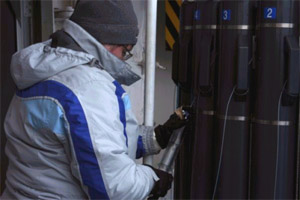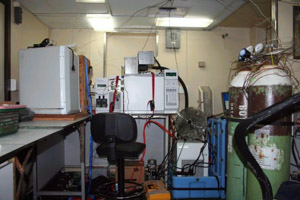 |
| Shari-Yvon Lewis taking a water sample from the rosette for CFC analysis |
It is particularly challenging to collect and analyze these samples on this cruise. We use large glass syringes to collect the water samples without any contamination from the atmosphere. However, in the cold we need to wear gloves, and it is very difficult to hold the slippery syringes in our cold gloved hands while collecting samples. When the ship is rolling, it is even more difficult. We then have to try to analyze the samples as quickly as possible, but there are many places we need to collect samples. Running the analysis and keeping up with the sampling is tough. Also, we are from the US, and all of our instruments run on US power. We had to set up a bunch of high powered transformers to allow us to use our scientific instruments on the Hesperides which has European power.
 |
| The small lab of the Hesperides where TAMU has mounted the equipment for CFC analysis |
Life on the ship is a bit different than back home. Yina, Julia and I each work an 8 hour shift to cover the sampling and analysis 24 hours per day. When I am not officially on shift, I am on call in case there is any difficulty in the lab that needs my attention. I spend my off time writing emails to my family, reading, and catching up on some of the data analysis. I am a vegetarian, so the meals have been a bit of a challenge, as they serve a lot of meat. However, the crew has been very kind to offer me an option at meals that I can eat. I have been quite pleased with this.
 |
| Penguins resting on an iceberg |
So far, I have seen some penguins, some other birds, and some icebergs. I hope to see more. I liked the seals I saw on my last Antarctic cruise, and I hope to see some on this one, too. I’d also like to see some whales. Sincerely,
Local time: 18.00 h (20.00 GMT)
Location: latitude: 60º 13’ 13’’ S; longitude: 49º 48’ 51’’ W
Wind: 6 m/s
Air temperature: 3.4ºC
Surface water temperature: 0.43ºC